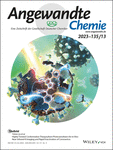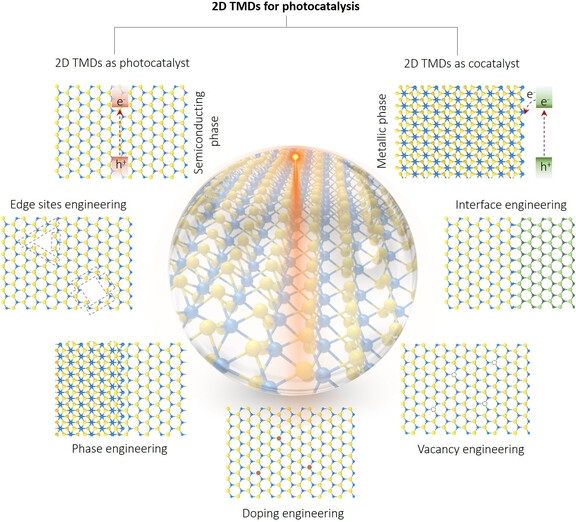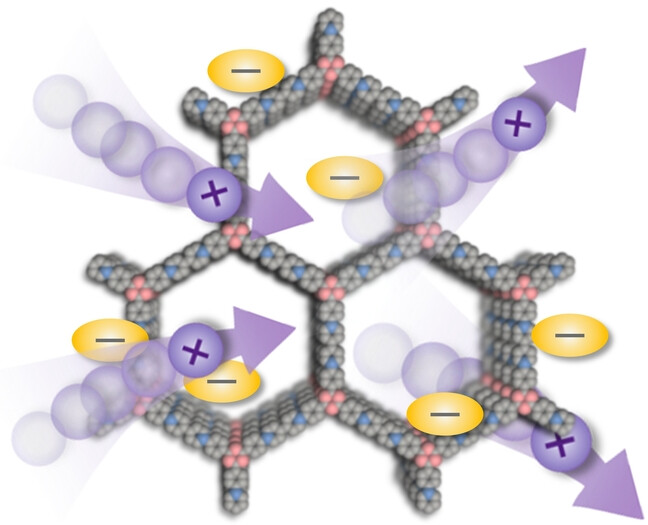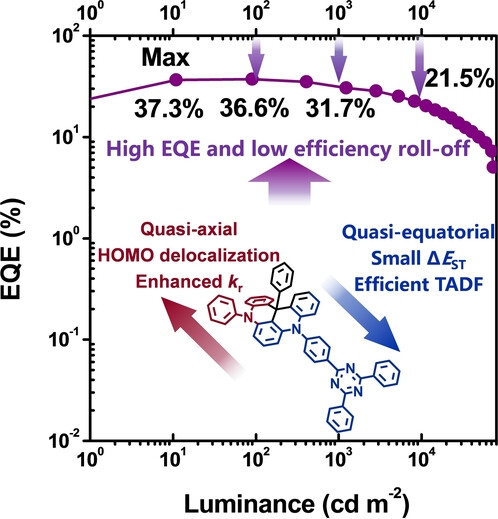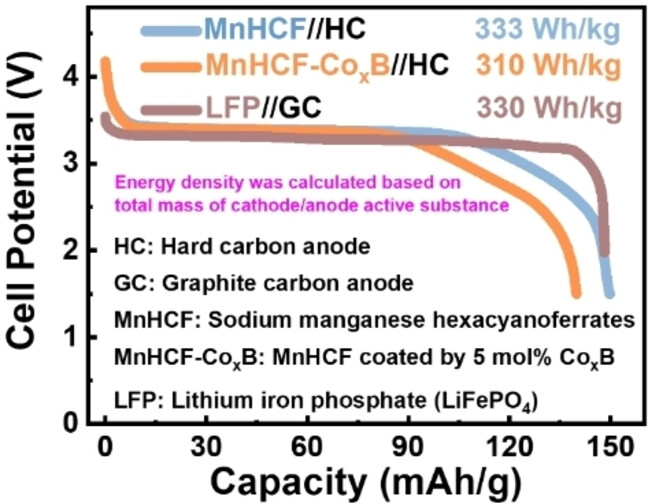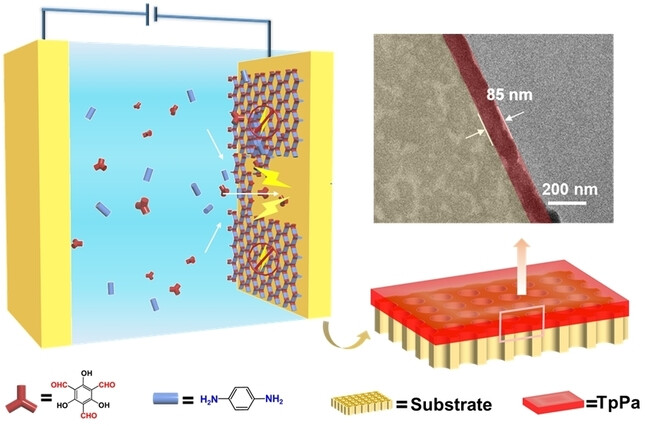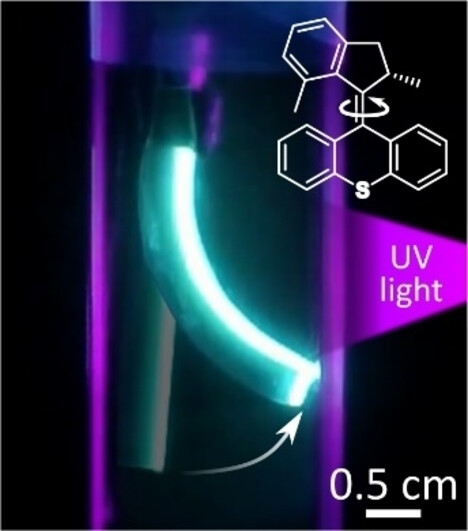Journal list menu
Export Citations
Download PDFs
Titelbild
Titelbild: Highly Twisted Conformation Thiopyrylium Photosensitizers for In Vivo Near Infrared-II Imaging and Rapid Inactivation of Coronavirus (Angew. Chem. 13/2023)
- First Published: 27 February 2023
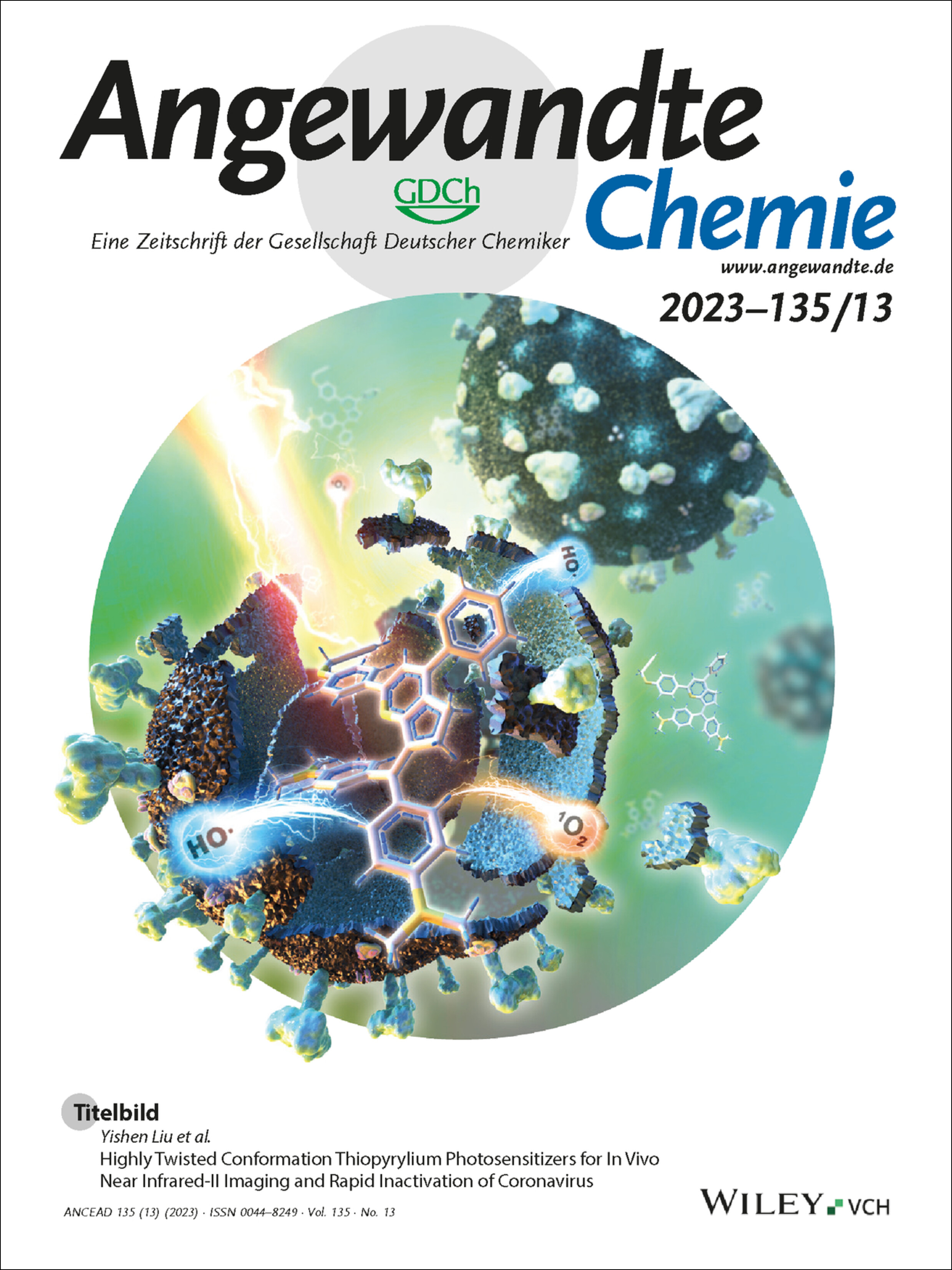
The relationship between molecular configuration and charge transfer processes in near-infrared-II (NIR-II) chromophores was studied, and subsequently instructed the engineering of an efficient NIR photosensitizer (PS), as reported by Wenbo Hu, Yuliang Xiao et al. in their Research Article (e202214875). The resulting NIR-II PS not only enables NIR-II image-guided in vivo pulmonary coronavirus photo-ablation but also demonstrates a facile approach for the development of NIR heavy-atom-free PSs.
Innentitelbild: Bending Actuation of Hydrogels through Rotation of Light-Driven Molecular Motors (Angew. Chem. 13/2023)
- First Published: 09 February 2023
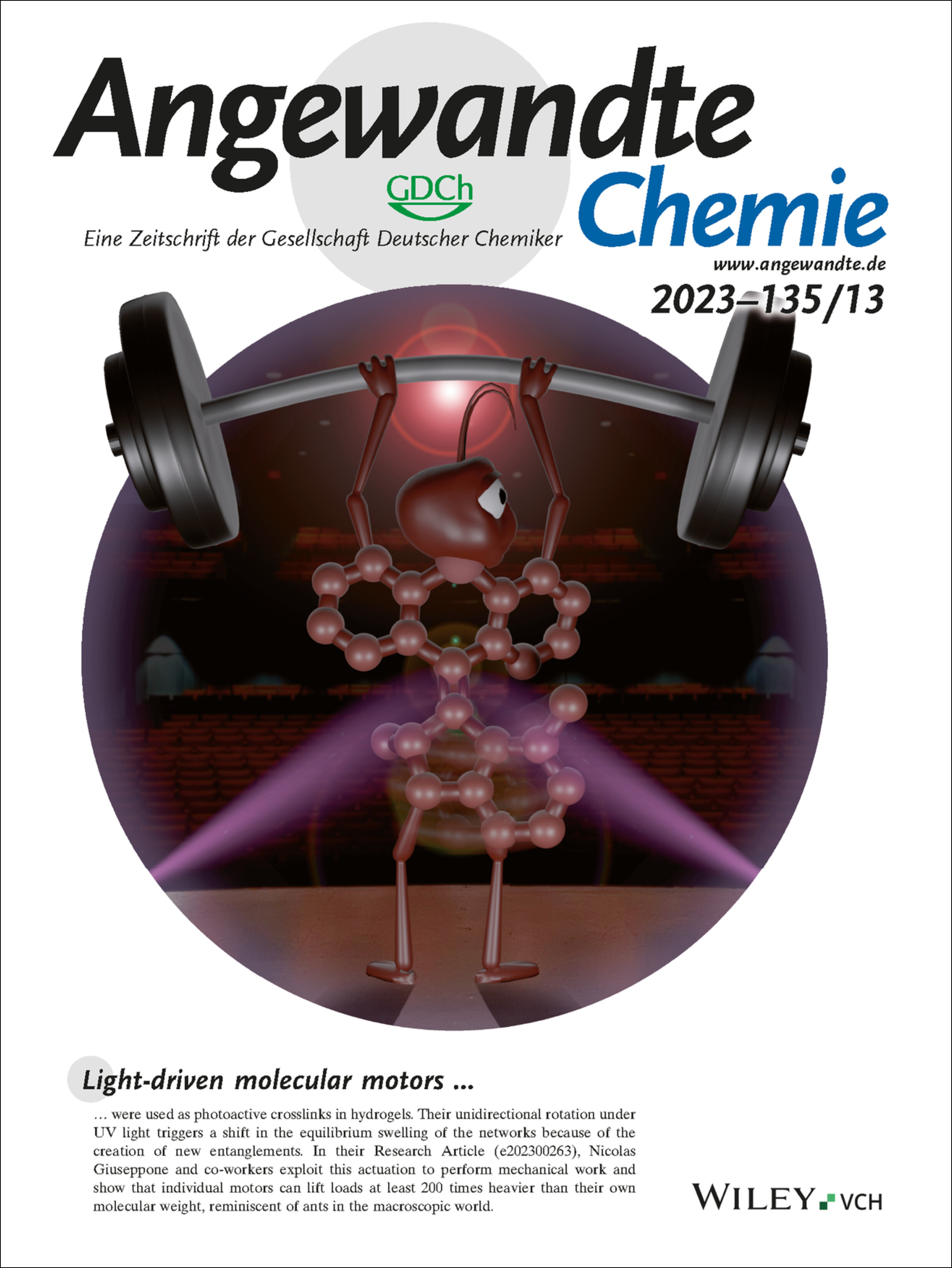
Light-driven molecular motors were used as photoactive crosslinks in hydrogels. Their unidirectional rotation under UV light triggers a shift in the equilibrium swelling of the networks because of the creation of new entanglements. In their Research Article (e202300263), Nicolas Giuseppone and co-workers exploit this actuation to perform mechanical work and show that individual motors can lift loads at least 200 times heavier than their own molecular weight, reminiscent of ants in the macroscopic world.
Innenrücktitelbild: Rigid-Flexible Hybrid Porous Molecular Crystals with Guest-Induced Reversible Crystallinity (Angew. Chem. 13/2023)
- First Published: 27 February 2023
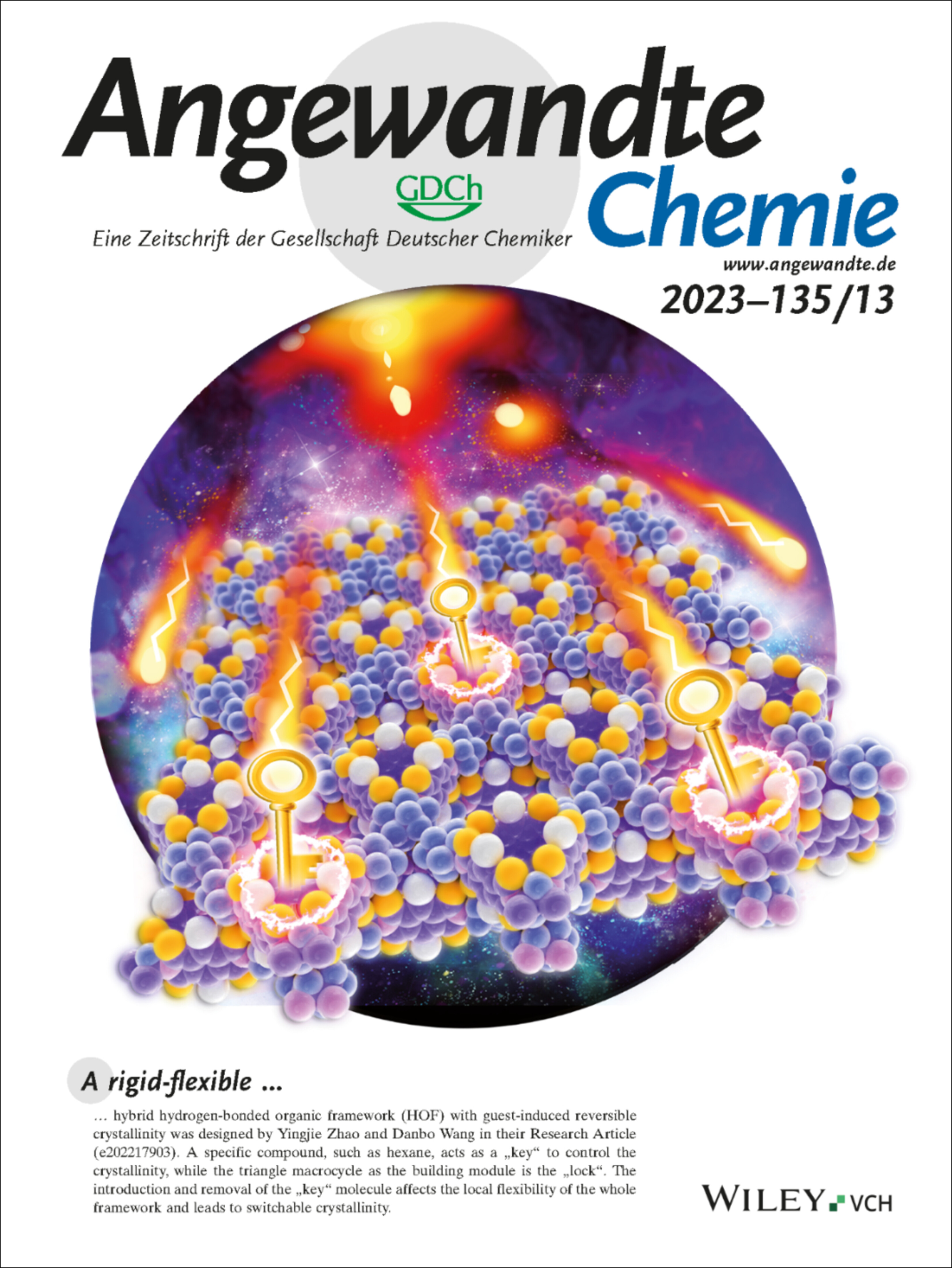
A rigid-flexible hybrid hydrogen-bonded organic framework (HOF) with guest-induced reversible crystallinity was designed by Yingjie Zhao and Danbo Wang in their Research Article (e202217903). A specific compound, such as hexane, acts as a “key” to control the crystallinity, while the triangle macrocycle as the building module is the “lock”. The introduction and removal of the “key” molecule affects the local flexibility of the whole framework and leads to switchable crystallinity.
Rücktitelbild: Bor-Zentrierte Lewis-Supersäuren durch Redoxaktive Liganden: Anwendung in der C-F- und S-F-Bindungsaktivierung (Angew. Chem. 13/2023)
- First Published: 06 March 2023
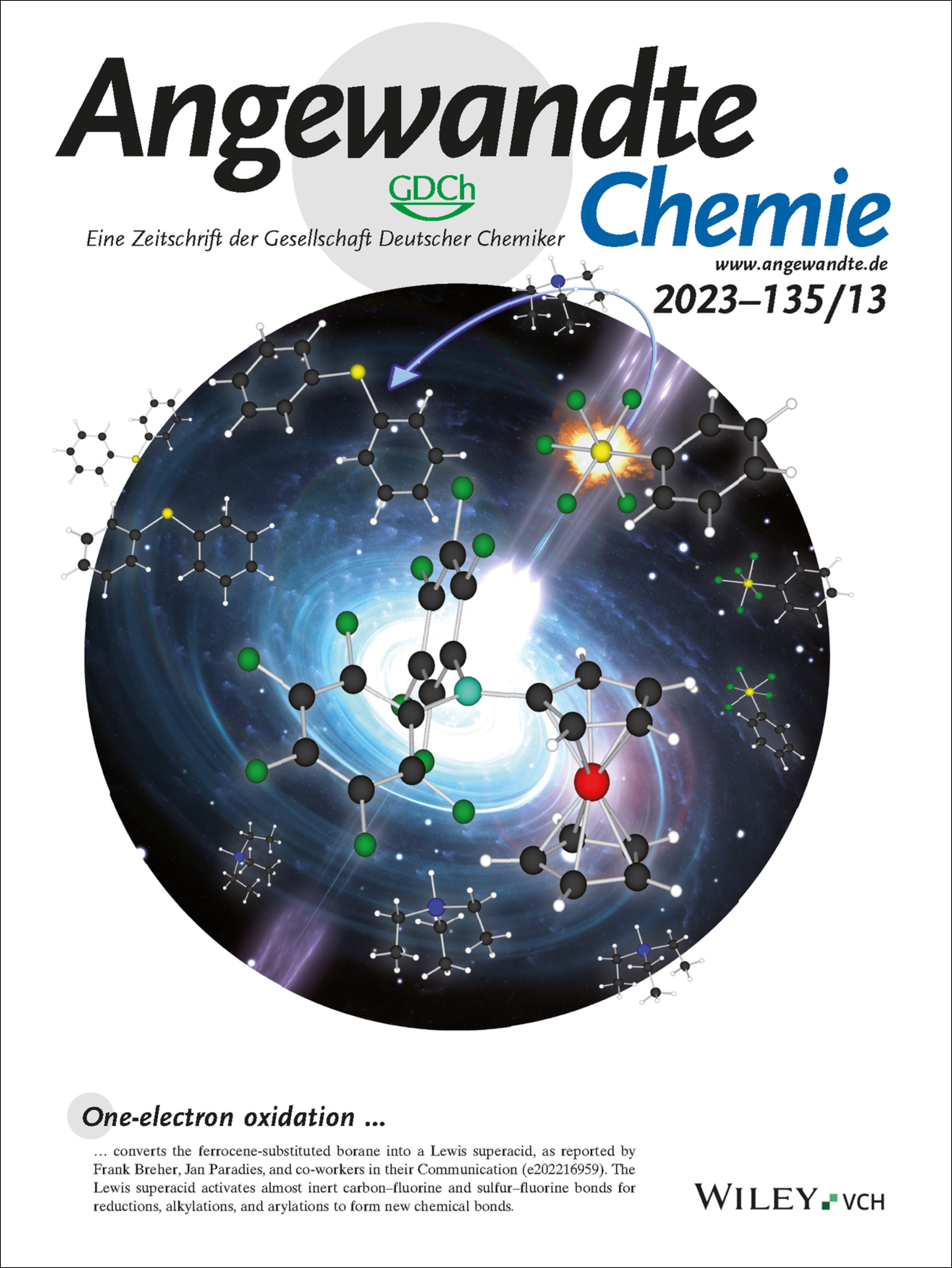
One-electron oxidation converts the ferrocene-substituted borane into a Lewis superacid, as reported by Frank Breher, Jan Paradies, and co-workers in their Communication (e202216959). The Lewis superacid activates almost inert carbon–fluorine and sulfur–fluorine bonds for reductions, alkylations, and arylations to form new chemical bonds.
Frontispiz
Frontispiz: Selective Separation of Lithium, Magnesium and Calcium using 4-Phosphoryl Pyrazolones as pH-Regulated Receptors
- First Published: 13 March 2023
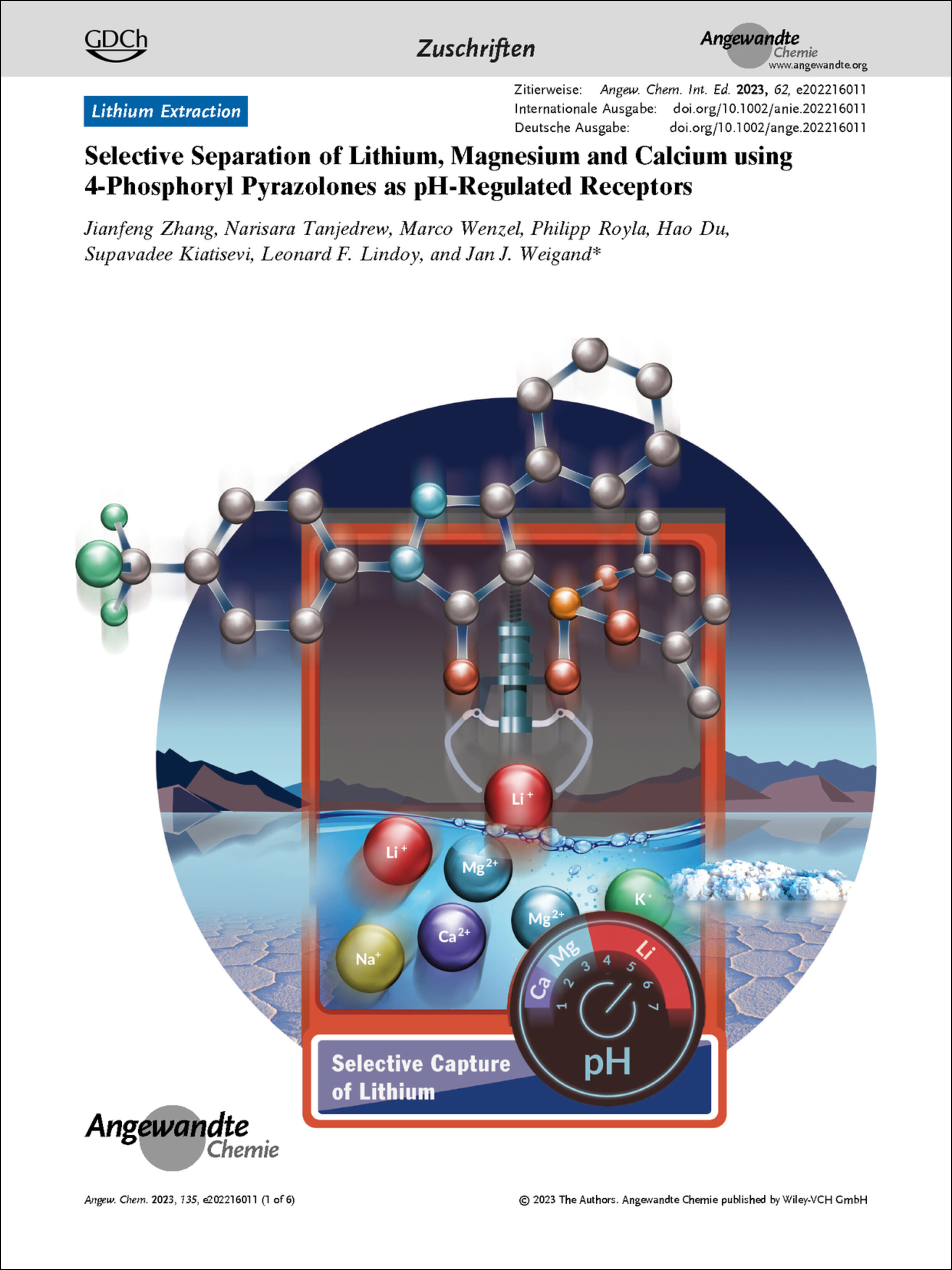
Receptors. In their Communication (e202216011), Jan J. Weigand et al. report the selective separation of lithium, magnesium, and calcium using 4-phosphoryl pyrazolones as pH-regulated receptors.
Frontispiz: Ein Verbindung-I-Analogon deckt die vorübergehende aktive Spezies eines Zytochrom-P450-Enzymes auf: Einblick in die Stereoselektivität P450-katalysierter Oxidationen
- First Published: 13 March 2023

Enzymes. In their Research Article (e202215706), Hiroshi Sugimoto, Osami Shoji et al. report the crystal structure of cytochrome P450BM3 mimicking the state of the enzyme in the moment preceding epoxidation.
Graphisches Inhaltsverzeichnis
Graphisches Inhaltsverzeichnis: Angew. Chem. 13/2023
- First Published: 13 March 2023
Announcement
Introducing …
Hua Sheng
- First Published: 02 February 2023

“A turning point in my career was when I started to learn how to use and build an in situ FTIR spectroscopy system in the second year of my PhD, and now, the mechanistic elucidation of interfacial photocatalytic reactions via in situ spectroscopy is the most critical part in my research … I'm always in a good mood when I talk with my students about their recent research progress …” Find out more about Hua Sheng in his Introducing … Profile.
Highlights
Electrochemiluminescence
Towards Electrochemiluminescence Microscopy Exploration of Plasmonic-Mediated Phenomena at the Single-Nanoparticle Level
- First Published: 09 January 2023
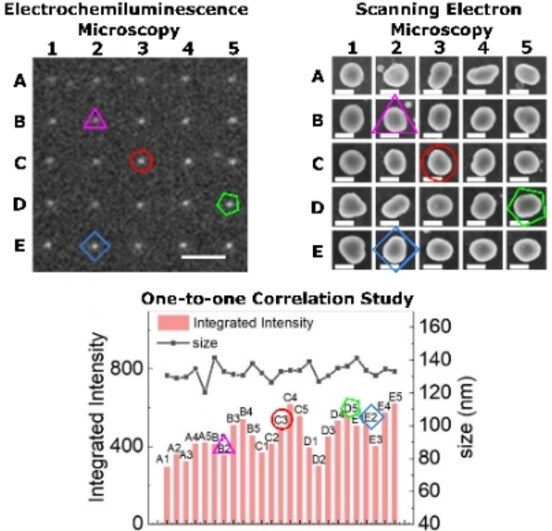
Electrochemiluminescence microscopy is emerging as a high-throughput spectroscopic technique capable of elucidating plasmonic-related phenomena in operando conditions. In a recent work, Wei et al. combine electrochemiluminescence microscopy and high resolution scanning electron microscopy to explore the plasmon-enhanced luminescence in gold nanostructures arrays, identifying two different enhancement mechanisms for isolated and coupled nanostructures.
Batteries
Solid-Electrolyte Interphase Chemistries Towards High-Performance Aqueous Zinc Metal Batteries
- First Published: 07 January 2023

The recent work from Guo and co-workers who proposed a hybrid electrolyte strategy obtained by mixing H2O and dimethyl methylphosphonate (DMMP) as solvents to build up a high-quality phosphate-based solid-state interphase layer is highlighted. This new solid electrolyte interphase (SEI) protects Zn metal anodes from corrosion and dendrite formation. Thus, ultrahigh Coulombic efficiencies and extended lifespan can be achieved.
Kurzaufsätze
Carbenes
Electron-Rich Oxycarbenes: New Synthetic and Catalytic Applications beyond Group 6 Fischer Carbene Complexes
- First Published: 03 January 2023
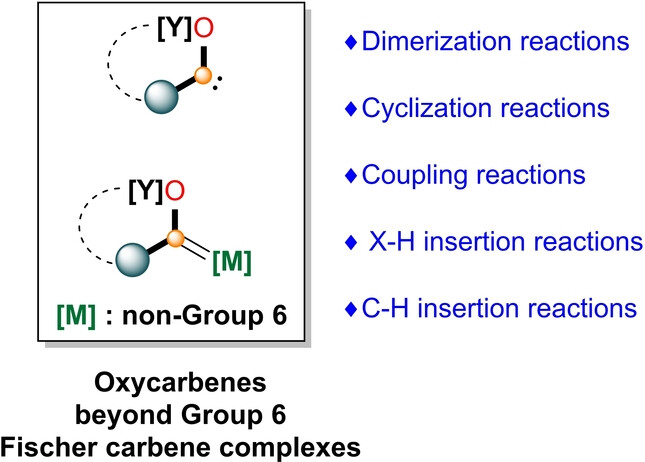
Oxycarbenes have emerged as useful intermediates in synthetic chemistry. This Minireview summarizes early synthetic and catalytic applications of late-transition-metal oxycarbene complexes and highlights recent advances in free oxycarbene reactions and transition-metal-catalyzed reactions involving oxycarbenes.
Chemical Protein Synthesis
Chemical Synthesis of Bioactive Proteins
- First Published: 20 January 2023

Protein chemistry has evolved remarkably in the past decade, which has enabled the effective production of new molecules with novel physicochemical properties for biomedical research, and therapeutic applications. This minireview summarizes recent developments in chemical protein synthesis to produce bioactive proteins, with emphasis on novel analogs with promising in vitro and in vivo activity.
Aufsätze
Molecular Electronics
Characterization and Application of Supramolecular Junctions
- First Published: 31 December 2022
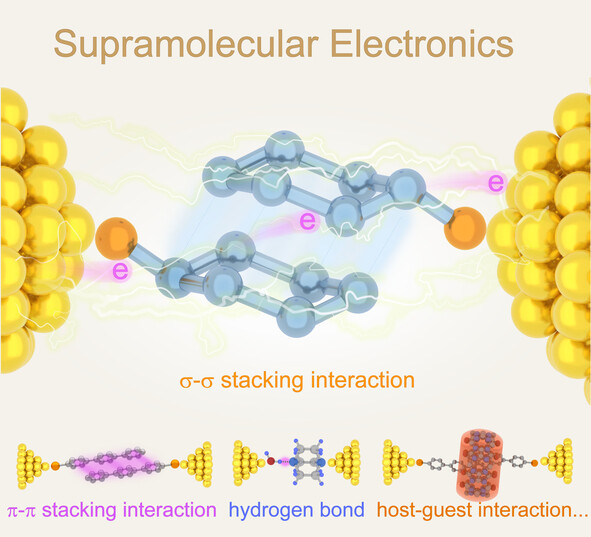
This review presents an overview of supramolecular electronics, an emerging and rapidly growing field that converges supramolecular chemistry and single-molecule electronics. Intensive attention is paid to depicting the electrical properties of various individual supramolecular assemblies and the unique quantum effects during intermolecular charge transport. Moreover, the dynamic monitoring of the supramolecular assembly processes at the single-molecule scale and the application of supramolecular electronics are also discussed.
Photocatalysis
Zuschriften
Lithium Extraction
Selective Separation of Lithium, Magnesium and Calcium using 4-Phosphoryl Pyrazolones as pH-Regulated Receptors
- First Published: 10 January 2023
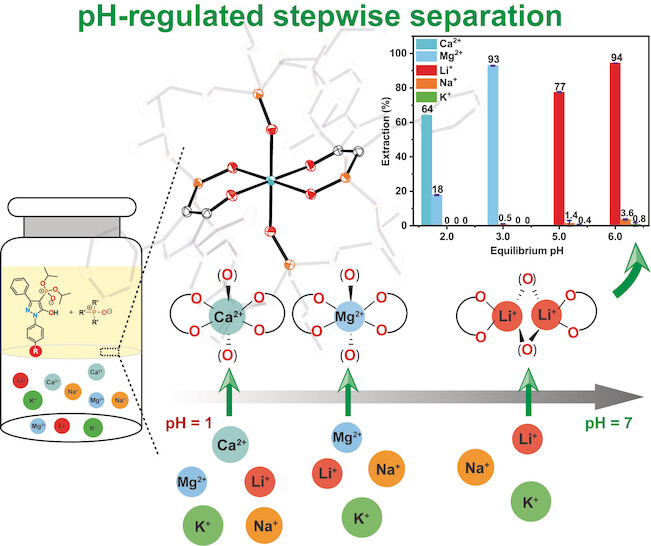
Stepwise separation of Ca2+, Mg2+ and Li+ has been achieved by liquid-liquid extraction employing a series of advanced 4-phosphoryl pyrazolone ligands together with TOPO (trioctylphosphine oxide) as co-ligand via pH regulation. X-ray crystal structure determinations of selected complexes revealed diverse binding modes across all three metal species.
Electrosynthesis of Ethylene Chlorohydrin | Very Important Paper
Preferential Adsorption of Ethylene Oxide on Fe and Chlorine on Ni Enabled Scalable Electrosynthesis of Ethylene Chlorohydrin
- First Published: 03 February 2023
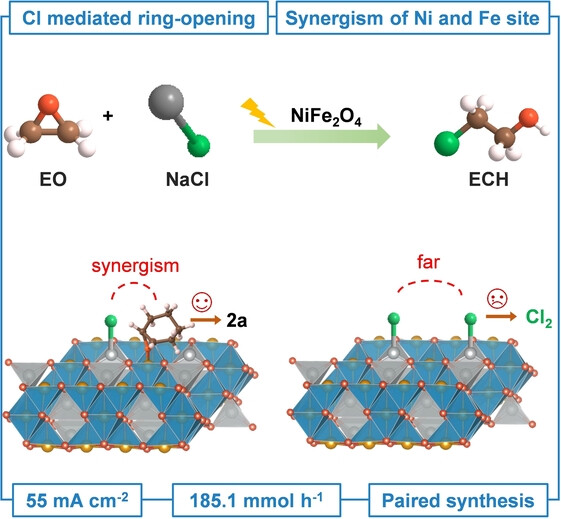
Preferential adsorption of ethylene oxide on Fe and chlorine on Ni enabled the electrosynthesis of ethylene chlorohydrin (ECH) with high conversion and selectivity. Scalable production of 185.1 mmol of ECH with 92.5 % yield at 55 mA cm−2 in 1 h, paired synthesis of ECH and 4-amino-3,6-dichloropyridine-2-carboxylic acid (an herbicide), and successful fabrication of a series of other chloro- and bromoethanols highlight the potential utilities.
Li Metal Batteries | Hot Paper
Halide Layer Cathodes for Compatible and Fast-Charged Halides-Based All-Solid-State Li Metal Batteries
- First Published: 25 January 2023
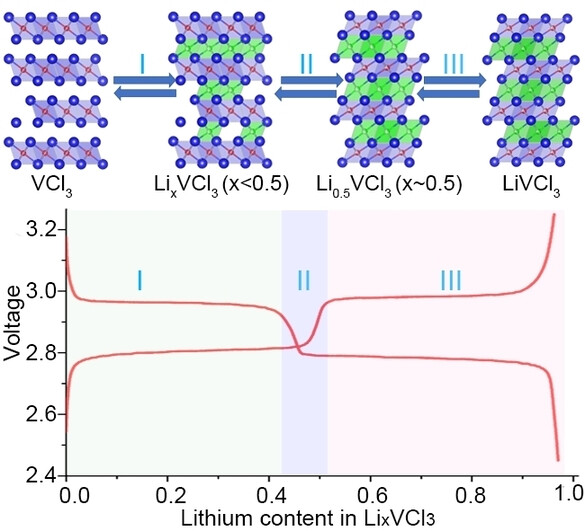
A lithium intercalation chemistry in layered VX3 (X=Cl, Br, I) enabled by compatible halide-based solid electrolytes was explored for the first time. The electrode-electrolyte interfacial stability can be achieved in a thermodynamic manner instead of by passivation, ensured by the good chemical stability between the VX3 cathode and halide electrolytes as well as the wide electrochemical stability windows.
Asymmetric Catalysis
Rhodium-Catalyzed Asymmetric Arylation of Cyclobutenone Ketals
- First Published: 02 February 2023

We report bench-stable cyclobutenone surrogates that undergo Rh-catalyzed addition of aryl- and vinylboronic acids to yield cyclobutenyl enol ethers in high yields and excellent enantioselectivities. This transformation proceeds via enantioselective carbometalation to give cyclobutyl-rhodium intermediates, followed by β-oxygen elimination. The reaction is fast and proceeds under mild conditions.
All-Solid-State Batteries
New Oxyhalide Solid Electrolytes with High Lithium Ionic Conductivity >10 mS cm−1 for All-Solid-State Batteries
- First Published: 06 February 2023
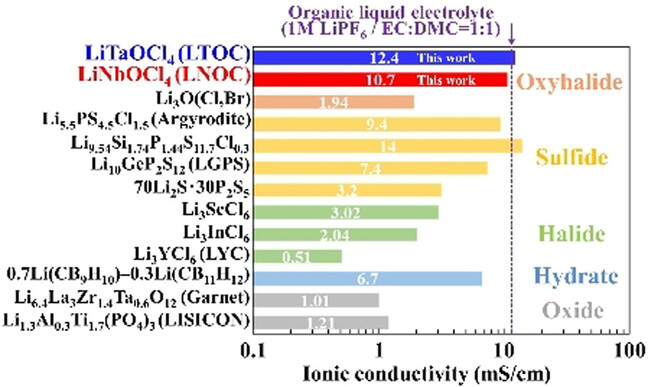
Here, we discover new lithium-metal-oxy-halide materials, LiMOCl4 (M=Nb, Ta). They exhibit extremely high ionic conductivities of 10.4 mS cm−1 for M=Nb and 12.4 mS cm−1 for M=Ta, respectively, even in cold-pressed powder forms at room temperature, which are comparable to or surpass those of organic liquid electrolytes used in lithium-ion batteries.
Overall Nitrogen Fixation | Hot Paper
Pulsed Electrocatalysis Enabling High Overall Nitrogen Fixation Performance for Atomically Dispersed Fe on TiO2
- First Published: 06 February 2023

Atomically dispersed Fe was designed on TiO2 and explored as a Janus electrocatalyst for both nitrogen oxidation reaction (NOR) and nitrogen reduction reaction (NRR) in a two-electrode system. Pulsed electrochemical catalysis (PE) was further involved to inhibit the competitive hydrogen evolution reaction (HER) and oxygen evolution reaction (OER) for superior nitrogen fixation performance.
C−H Functionalization
Enantioselective Intermolecular Radical Amidation and Amination of Benzylic C−H Bonds via Dual Copper and Photocatalysis
- First Published: 31 January 2023

A method for enantioselective intermolecular benzylic C−H amidation and amination is reported. This dehydrogenative C−N bond formation displays broad substrate scope and good atom economy, is amenable to late-stage C−H functionalization, and enables easy access to 15N-labeling from cheap [15N]-NH4Cl.
Electrocatalysis
Enabled Efficient Ammonia Synthesis and Energy Supply in a Zinc–Nitrate Battery System by Separating Nitrate Reduction Process into Two Stages
- First Published: 02 February 2023
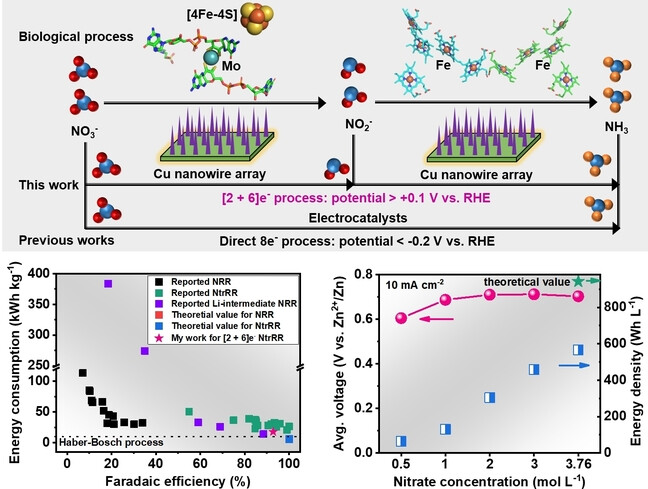
For the efficient electrocatalytic conversion of NO3− to NH3, a two-stage process following the [2+6]-electron pathway is proposed inspired by biological nitrate respiration. This system produces NO2− and NH3 at low overpotentials (>+0.1 vs. RHE), resulting in a low energy consumption of 17.7 kWh kg−1 for NH3 production and high energy density of 566.7 Wh L−1 at 10 mA cm−2 for Zn−NO3− battery.
Lewis Acids
A Bidentate Ligand Featuring Ditopic Lewis Acids in the Second Sphere for Selective Substrate Capture and Activation
- First Published: 31 January 2023
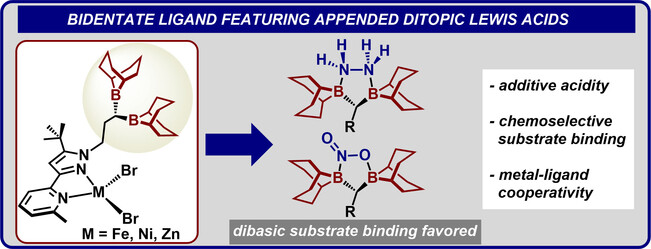
We report the synthesis of a bidentate ligand featuring secondary sphere ditopic Lewis acids. We verify a Lewis acid additivity effect for the ditopic boranes compared to a monotopic analogue using hydride ion affinity and competition studies. We show chemoselective nitrite capture in the presence of other anions. Pre-organized hydrazine adducts in the second sphere of Zn and Fe are functionalized to hydrazido and diazene ligands, respectively.
Nitrate Reduction Reaction
Tandem Electrocatalytic Nitrate Reduction to Ammonia on MBenes
- First Published: 03 February 2023

MBenes are demonstrated to be a new class of tandem catalysts for electrocatalytic nitrate reduction to ammonia (NO3RR). Taking FeB2 as the proof-of-concept paradigm, mechanistic studies unveil that the synergistic tandem effect of Fe and B atoms promotes NO3− activation and intermediate hydrogenation to enhance the NO3RR activity and selectivity.
Dual-ion Batteries
Ion Co-storage in Porous Organic Frameworks through On-site Coulomb Interactions for High Energy and Power Density Batteries
- First Published: 05 February 2023
Porphyrinoids
A Quadruply Bridged Non-Offset Face-to-Face Porphyrin Dimer and Cross-Shaped Pentameric Porphyrin Tapes Based on 2,7,12,17-Tetrakis(pinacolatoboryl) NiII Porphyrin
- First Published: 06 February 2023

The Ir-catalyzed borylation of porphine has led to the synthesis of the useful synthon 2,7,12,17-tetrakis(pinacolatoboryl) NiII porphyrin. This synthon was used for the preparation of tetraarylated NiII porphyrins, octaarylated NiII porphyrins, a quadruply bridged non-offset face-to-face porphyrin dimer, single-linked cross-shaped porphyrin pentamers and nonamers, as well as pentameric porphyrin tapes.
Gas Separation | Very Important Paper
Tetranuclear CuII Cluster as the Ten Node Building Unit for the Construction of a Metal–Organic Framework for Efficient C2H2/CO2 Separation
- First Published: 01 February 2023
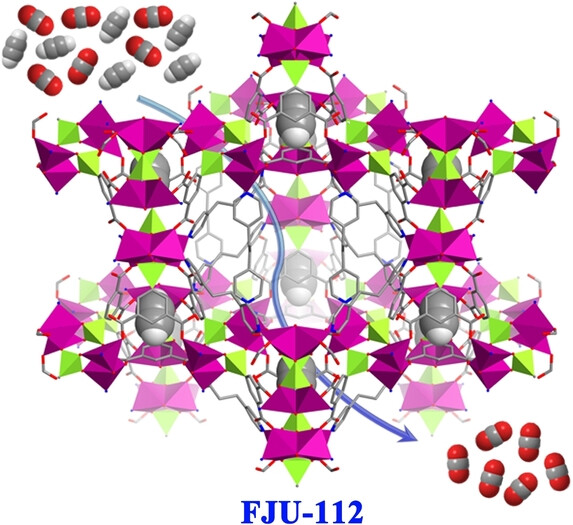
The ten-connected tetranuclear copper-based cluster node [Cu4(PO3)2(μ2-H2O)2(CO2)4] formed by the organic ligand H4L (3,5- dicarboxyphenylphosphonic acid) leads to a novel metal–organic framework FJU-112. BPE (1,2-bis(4-pyridyl)ethane) divides the larger pore space of FJU-112 into a structure with smaller aperture size and infinite cages which greatly enhances the adsorption and selective separation performance for C2H2/CO2 mixtures.
Targeted Degradation
Dendronized DNA Chimeras Harness Scavenger Receptors To Degrade Cell Membrane Proteins
- First Published: 03 February 2023
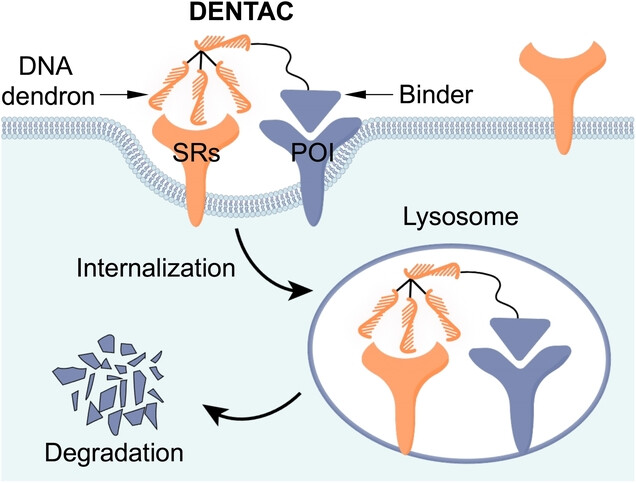
A general and efficient dendronized DNA chimera (DENTAC) strategy for targeted membrane protein degradation is reported. DENTAC comprises a protein-of-interest (POI) binder linked with a dendritic DNA, which engages cell surface scavenger receptors (SRs) to transport the POI into the lysosome for degradation.
Homogeneous Catalysis
Optically Controlled Recovery and Recycling of Homogeneous Organocatalysts Enabled by Photoswitches
- First Published: 23 January 2023
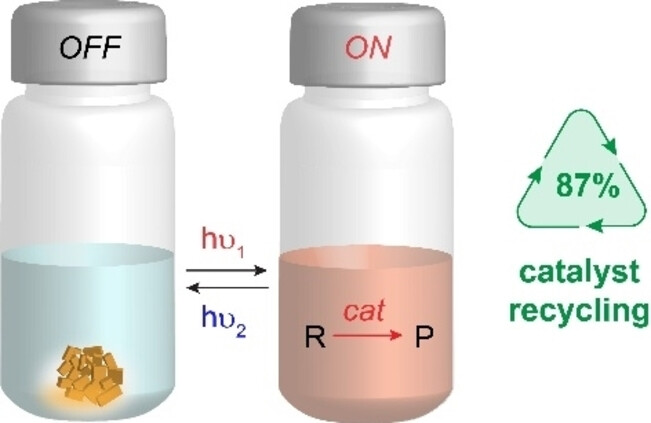
Photoswitchable organocatalysts have been generated that undergo reversible dissolution and precipitation upon photo-irradiation. The insoluble solid-state catalysts are photo-switched to form soluble isomers that activate and complete two types of base-catalyzed reactions. Irradiation with visible light promotes the precipitation of the catalyst with a recovery rate of 87 %, which can be reused in multiple rounds of subsequent reactions.
Lewis-Säuren
Bor-Zentrierte Lewis-Supersäuren durch Redoxaktive Liganden: Anwendung in der C-F- und S-F-Bindungsaktivierung
- First Published: 09 January 2023
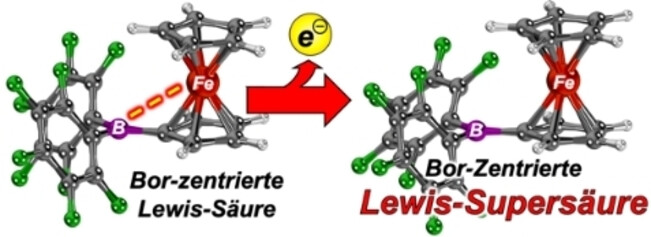
Die Oxidation von Ferrocenyl-substituierten Boranen und Boronsäureestern ermöglicht die unkomplizierte Synthese Bor-zentrierter Lewis-Supersäuren. Die Verbindungen wurden mit NMR, XRD und FIA-Berechnungen charakterisiert. Die Ferrocenium-substituierten Borane wurden in der katalytischen Aktivierung von C-F- und S-F-Bindungen eingesetzt.
MOFs für die Phosphanspeicherung | Hot Paper
Festkörper-Analyse, Speicherung und Trennung von Pyrophorem PH3 und P2H4 mit α-Mg Formiat
- First Published: 16 January 2023

Phosphan, PH3, ist ein hochpyrophores und toxisches Gas, welches oft mit H2 und P2H4 verunreinigt ist. Das kostengünstige α-Mg Formiat-MOF adsorbiert bis zu 10 wt % PH3 und ermöglicht eine sichere Handhabung von Phosphan an Luft. Dieses MOF ist außerdem ein Kandidat für PH3-Reinigung und P2H4-Langzeitspeicherung an Luft und bei Raumtemperatur.
Forschungsartikel
Enzymmechanismen | Hot Paper
Ein Verbindung-I-Analogon deckt die vorübergehende aktive Spezies eines Zytochrom-P450-Enzymes auf: Einblick in die Stereoselektivität P450-katalysierter Oxidationen
- First Published: 15 December 2022
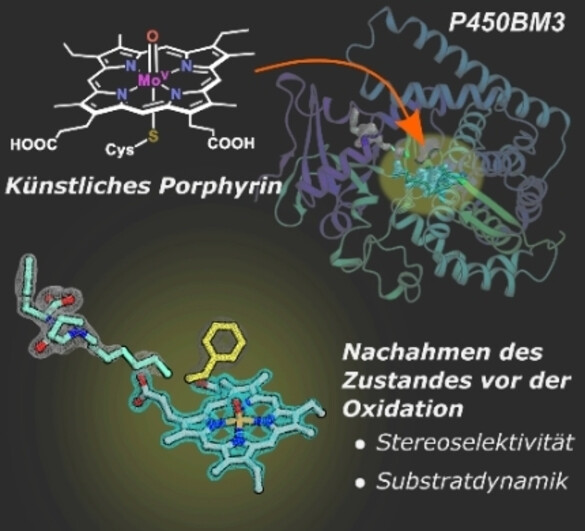
Schnappschüsse von Zytochrom-P450-Enzymen mit ihren Substraten in katalytisch relevanten Konformationen zu erhalten stellt eine langjährige Herausforderung dar. Unter Ausnutzung der Eigenschaften eines künstlichen Porphyrins, das der äußerst instabilen aktiven Spezies von P450 ähnelt, konnte Styrol in Konformationen erfasst werden, die mit den experimentell ermittelten Ergebnissen übereinstimmen. Dieser Ansatz stellt ein vielversprechendes Hilfsmittel für die gezielte Entwicklung leistungsfähigerer P450-Biokatalysatoren dar.
Kooperative Katalyse
Ein praktikabler und robuster zwitterionischer kooperativer Lewis-Säure-/Acetat-/Benzimidazolium-Katalysator für direkte 1,4-Additionen
- First Published: 18 January 2023
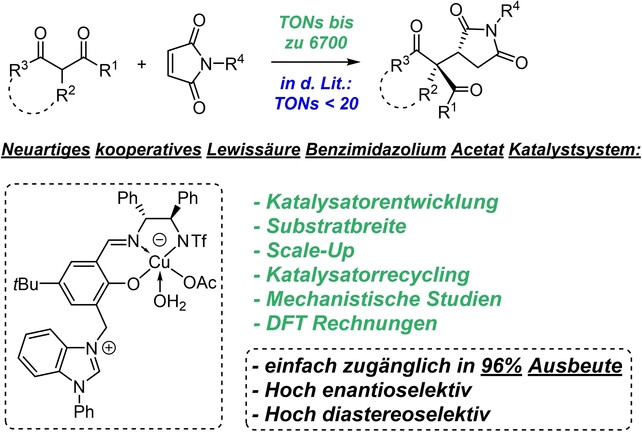
Die intramolekulare Kooperation von CuII, koordiniertem Acetat und einer Benzimidazolium-Einheit in der Katalysatorperipherie ermöglicht eine beispiellose Katalysatorproduktivität und eine hohe Stereokontrolle bei direkten 1,4-Additionen an Maleimide und eine Reihe weiterer Michael-Akzeptoren. Trotz ausgeklügeltem Aktivierungsprinzip ist der Katalysator leicht herzustellen und weist eine hohe Robustheit auf. Darüber hinaus erwies sich der Katalysator als vielfach wiederverwendbar.
EPR Spectroscopy
Triggered Functional Dynamics of AsLOV2 by Time-Resolved Electron Paramagnetic Resonance at High Magnetic Fields
- First Published: 13 January 2023
Fluorescent Probes
Highly Twisted Conformation Thiopyrylium Photosensitizers for In Vivo Near Infrared-II Imaging and Rapid Inactivation of Coronavirus
- First Published: 22 December 2022

The relationship between molecular configuration and charge transfer process in NIR-II chromophores has been revealed, which informed the engineering of an efficient NIR photosensitizer (PS), SP@HD-PEG2K. The dramatic improvement of the reactive oxygen species (ROS) quantum yield of the PSs enabled NIR-II image-guided in vivo pulmonary coronavirus photoablation for the first time and created a convenient paradigm for the development of NIR heavy-atom-free PSs.
Photoacoustic Probes
Xanthene-Based Nitric Oxide-Responsive Nanosensor for Photoacoustic Imaging in the SWIR Window
- First Published: 01 February 2023
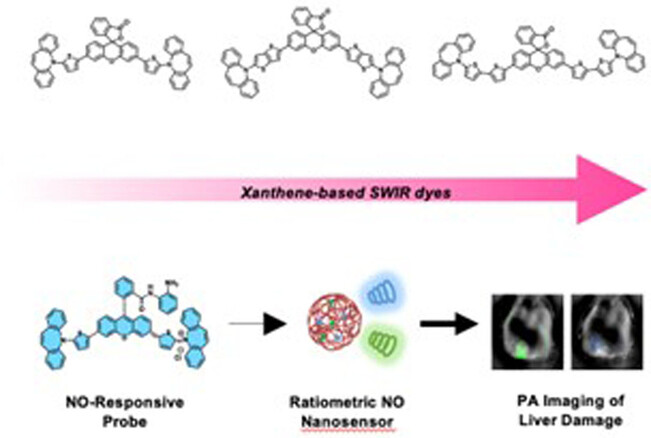
A panel of new SWIR dyes based on the xanthene core was synthesized using C−H activation chemistry. We showcased the biomedical utility of these imaging agents by selecting one example for the development of a ratiometric nanosensor, which we employed to detect elevated levels of nitric oxide in a murine model of drug-induced liver injury via SWIR PA imaging.
Biaryls
Towards Axially Chiral Pyrazole-Based Phosphorus Scaffolds by Dipeptide-Phosphonium Salt Catalysis
- First Published: 24 January 2023

A highly enantioselective reaction has been developed for the construction of axially chiral arylpyrazole skeletons with phosphorus unit. The reaction proceeds through a sequential Huisgen-type cycloaddition/aromatization process with central-to-axial chirality conversion using a dipeptide-phosphonium salt catalyst. Arylpyrazole-based atropisomeric phosphorus compounds are obtained in high yields with excellent enantioselectivities.
Zn-Ion Batteries
Vanadium Oxides with Amorphous-Crystalline Heterointerface Network for Aqueous Zinc-Ion Batteries
- First Published: 01 February 2023
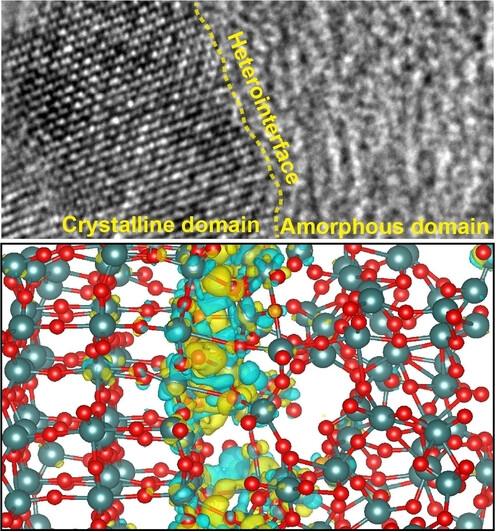
Vanadium oxide materials with the unique amorphous-crystalline heterostructure are fabricated using an electrochemical method for the first time. The electrode displays good electrochemical performances as cathode for aqueous Zn-ion batteries. Experimental and simulation results suggest that the amorphous-crystalline heterostructure exhibits the favourable cation adsorption and ion diffusion properties compared to other modelling structures.
Olefin Metathesis
Late-Stage Formal Double C−H Oxidation of Prenylated Molecules to Alkylidene Oxetanes and Azetidines by Strain-Enabled Cross-Metathesis
- First Published: 11 January 2023

A functional-group-tolerant, mild, formal double C−H oxidation protocol has been developed that can be used for the selective late-stage derivatization of prenylated compounds and natural products. This exocyclic-strain-driven cross-metathesis protocol allows the efficient coupling of highly substituted and electron-rich olefins.
Organic Light-Emitting Didoes
A Tetrahedral Bisacridine Donor Enables Fast Radiative Decay in Thermally Activated Delayed Fluorescence Emitter
- First Published: 01 February 2023
Synthetic Methods
Ring Expansion Strategies for the Synthesis of Medium Sized Ring and Macrocyclic Sulfonamides
- First Published: 30 January 2023

Two ring expansion strategies are reported for the synthesis of medium sized and macrocyclic sulfonamides. Both methods proceed without using classical protecting groups, initiated by nitro reduction and amine conjugate addition respectively, to make diversely functionalised cyclic sulfonamides in a range of ring sizes. The ring size dependency of the synthetic reactions is in good agreement with the outcomes modelled by Density Functional Theory.
Organometallic Chemistry
Evidence of AlII Radical Addition to Benzene
- First Published: 03 January 2023
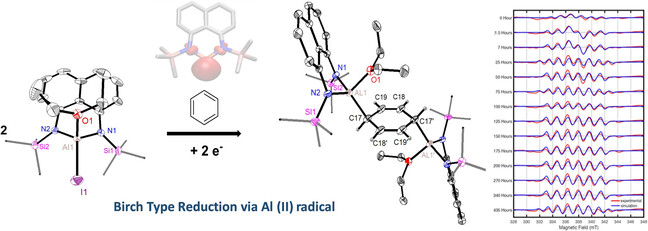
The electron reduction of diamido-naphthyl aluminum iodide in benzene produces dialuminyl substituted Birch-type reduction product. Time dependent EPR experiments in combination with DFT calculations suggest a reaction mechanism where stable AlII radical intermediates play a crucial role for the reaction outcome. The aluminum radical stability is a consequence of a rigid supporting ligand with silyl protective substituents.
Supramolecular Chemistry | Hot Paper
Visible Helicity Induction and Memory in Polyallene toward Circularly Polarized Luminescence, Helicity Discrimination, and Enantiomer Separation
- First Published: 06 February 2023
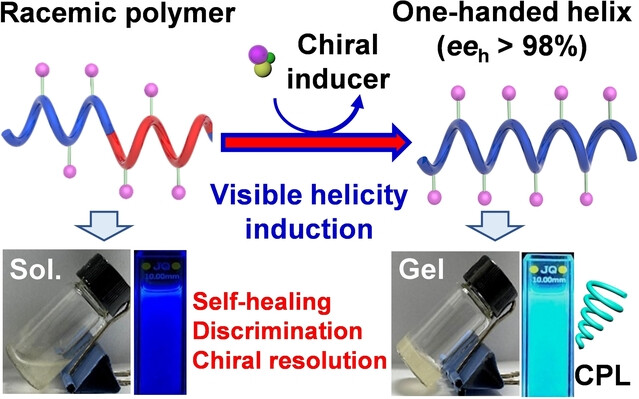
A family of racemic polymers were induced into one-handed helices which were memorized after the chiral inducer was removed. The enantiomeric excess of one handed helix (eeh) is up to 98 %. Interestingly, the switchable helix-induction is visible with the naked eye. Moreover, the one-handed helices exhibit enhanced stability with helicity discrimination and enantiomer separation abilities.
Protein Degradation | Hot Paper
Discovery of Norbornene as a Novel Hydrophobic Tag Applied in Protein Degradation
- First Published: 20 January 2023

A novel norbornene-based hydrophobic tag was developed that expands the clinical potential of targeted protein degradation technologies. The degrader Hyt-9, which was obtained by connecting an ALK ligand with norbornene, exhibited potent antiproliferative and degradative activities in vitro and in vivo. Furthermore, norbornene could be used to degrade EZH2 when tagged with the EZH2 inhibitor tazemetostat in degrader Hyt-13.
Nitrogen Reduction
Boosting Electroreduction Kinetics of Nitrogen to Ammonia via Atomically Dispersed Sn Protuberance
- First Published: 04 February 2023
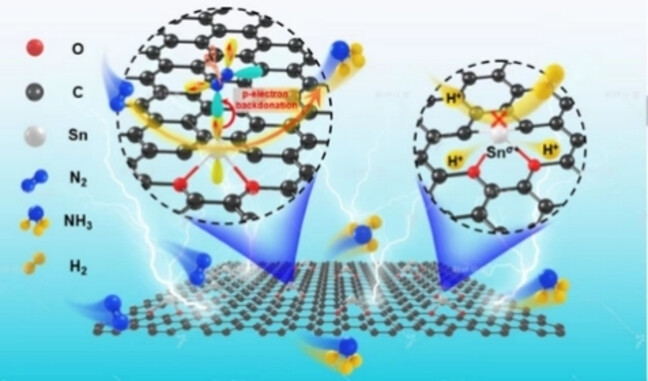
An asymmetric Sn atomically dispersed protuberance (ADP) having a special coordination with substrate C and O atoms was designed. This unique structure could induce positive charge accumulation on Sn site for improving its N2 adsorption, activation and thus the N2 reduction reaction (NRR) performance. As a result, the obtained Sn ADPs displayed an outstanding electrocatalytic activity, high selectivity stability, and durability in the NRR.
Biocatalysis
Engineering Cytochrome P450BM3 Enzymes for Direct Nitration of Unsaturated Hydrocarbons
- First Published: 20 January 2023

The peroxidase activity of a dual-functional small-molecule (DFSM)-facilitated P450BM3-H2O2 system was drastically improved through mechanism-guided protein engineering for the P450-mediated direct nitration of phenols, anilines, and styrenes using nitrite as the nitrating agent. Co-crystal structures revealed the crucial role of the steric effect introduced by site-directed mutations of proximal residues in the regulation of substrate access.
Oxygen Reduction | Hot Paper
Understanding Synergistic Catalysis on Cu-Se Dual Atom Sites via Operando X-ray Absorption Spectroscopy in Oxygen Reduction Reaction
- First Published: 24 January 2023
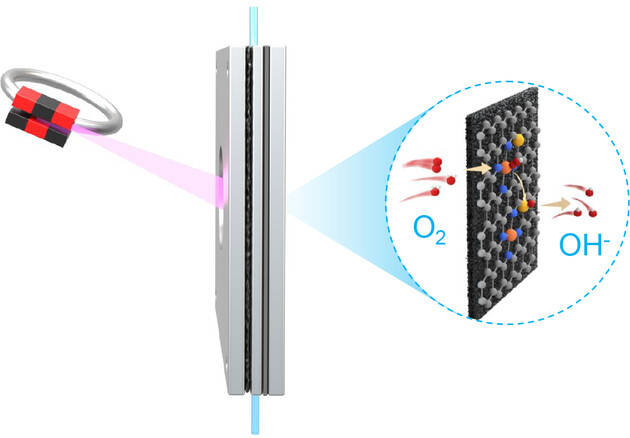
The synergistic oxygen reduction reaction that occurs on the Cu1-N4 and Se1-C3 dual-hetero-atom sites is revealed by the operando X-ray absorption spectroscopy under realistic Zn-air battery conditions, in which OOH*-(Cu1-N4) obtains one electron and is further transformed into the O*-(Se1-C2) intermediate.
Na-Ion Batteries | Very Important Paper
Surface Engineering Stabilizes Rhombohedral Sodium Manganese Hexacyanoferrates for High-Energy Na-Ion Batteries
- First Published: 31 January 2023
Aqueous Rechargeable Zinc Batteries | Hot Paper
Amphoteric Cellulose-Based Double-Network Hydrogel Electrolyte Toward Ultra-Stable Zn Anode
- First Published: 31 January 2023
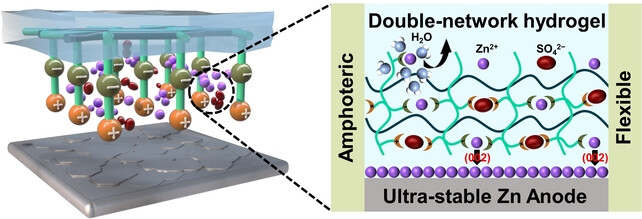
We designed a flexible amphoteric cellulose-based double-network hydrogel electrolyte. The amphoteric groups not only promoted the desolvation process of [Zn(H2O)6]2+ to eliminate side reactions, but also guided the Zn2+ deposition to inhibit dendrite growth, thus resulting in a ultra-stable Zn anode.
Asymmetric Catalysis
Sterically Hindered and Deconjugative α-Regioselective Asymmetric Mannich Reaction of Meinwald Rearrangement-Intermediate
- First Published: 26 January 2023

A sterically hindered and deconjugative α-regioselective asymmetric Mannich reaction of Meinwald rearrangement-intermediates was realized by using chiral N,N′-dioxide/ ScIII catalysts, offering chiral α-quaternary allyl aldehydes and alcohols in high efficiency. Experimental and computational studies showed that the steric hindrance of the ligand and the protecting group on the imine are critical factors influencing the α/γ-regioselectivity.
Polymerization
Mechanism-Guided Design of Chain-Growth Click Polymerization Based on a Thiol-Michael Reaction
- First Published: 03 February 2023
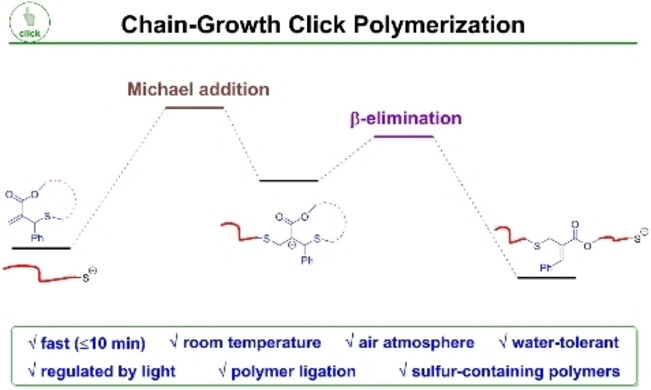
A new type of chain-growth click polymerization has been developed that can proceed quickly under ambient conditions. Mechanistic studies suggest the Michael addition controls the kinetics of the propagation process. In addition, this new polymerization can be spatiotemporally regulated by ultraviolet light, and the resulting polymers can be directly used for polymer ligations.
Porous Materials | Very Important Paper
Rigid-Flexible Hybrid Porous Molecular Crystals with Guest-Induced Reversible Crystallinity
- First Published: 31 January 2023
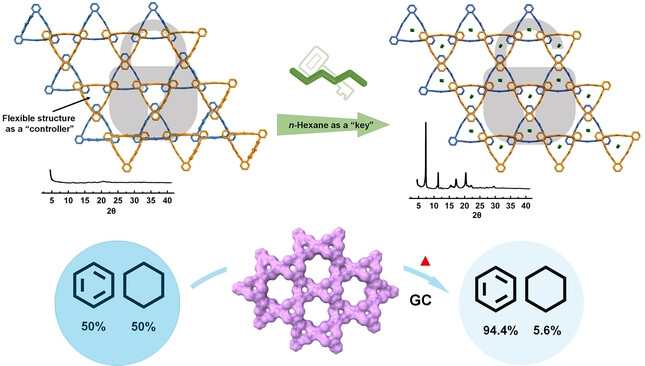
A globally robust HOF with both rigidity and flexibility was constructed. The non-crystalline and crystalline phases of the HOF could be easily and reversibly switched at will with the specific solvent molecule. Furthermore, the obtained HOF exhibits excellent separation efficiency for benzene and cyclohexane (94.4 %).
Solar Cells | Hot Paper
Dredging the Charge-Carrier Transfer Pathway for Efficient Low-Dimensional Ruddlesden-Popper Perovskite Solar Cells
- First Published: 31 January 2023

A new family of low-dimensional Ruddlesden-Popper perovskites (GABA)2MAn−1PbnI3n+1 (n=1, 2, 3, 4, MA+=CH3NH3+) with inhibited dielectric confinement were constructed with γ-aminobutyric acid (GABA) as the spacer cation. The hydrogen bonds between the spacers link the adjacent spacing sheets, enabling the charges localized in the van der Waals gap. The power conversion efficiency of (GABA)2MA4Pb5I16 solar cells with excellent carrier transport properties is up to 18.73 %.
Lithium Batteries
An Amphiphilic Molecule-Regulated Core-Shell-Solvation Electrolyte for Li-Metal Batteries at Ultra-Low Temperature
- First Published: 02 February 2023

A new amphiphilic solvent is rationally designed to induce self-assembly of the electrolyte solution to form a peculiar core-shell-solvation structure. Such unique solvation structure bestows improved ionic conductivity, low desolvation energy, and highly robust and conductive SEI, which overcomes the long-standing Li compatibility and deposition kinetic challenges, enabling the stable operation of Li-metal battery under ultra-low temperature.
Polymer Electrolytes | Hot Paper
Influencing Factors on Li-ion Conductivity and Interfacial Stability of Solid Polymer Electrolytes, Exampled by Polycarbonates, Polyoxalates and Polymalonates
- First Published: 30 January 2023

Three families of ester-based solid polymer electrolytes consisting of polycarbonate, polyoxalate and polymalonate were prepared and investigated on their Li+-conductivity and antioxidation ability. The performances of solid polymer electrolytes are affected by the coordinating capability with Li+, molecular asymmetry and existing modes of elemental F.
Nickel Catalysis
Directed Asymmetric Nickel-Catalyzed Reductive 1,2-Diarylation of Electronically Unactivated Alkenes
- First Published: 31 January 2023
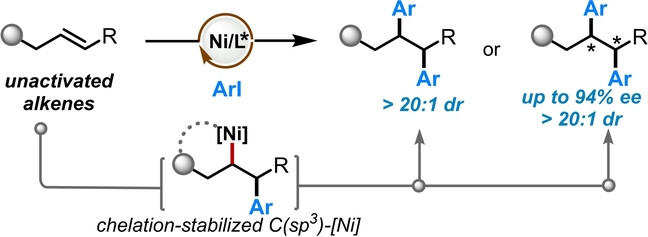
A highly diastereoselective Ni-catalyzed reductive 1,2-diarylation of unactivated internal alkenes was developed. Additionally, the enantioselective variant with unactivated terminal and challenging internal alkenes was also achieved, delivering various polyarylalkanes bearing benzylic stereocenters with good to high enantioselectivities and excellent diastereoselectivities.
Biosynthesis
ATP-Independent and Cell-Free Biosynthesis of β-Hydroxy Acids Using Vinyl Esters as Smart Substrates
- First Published: 31 January 2023
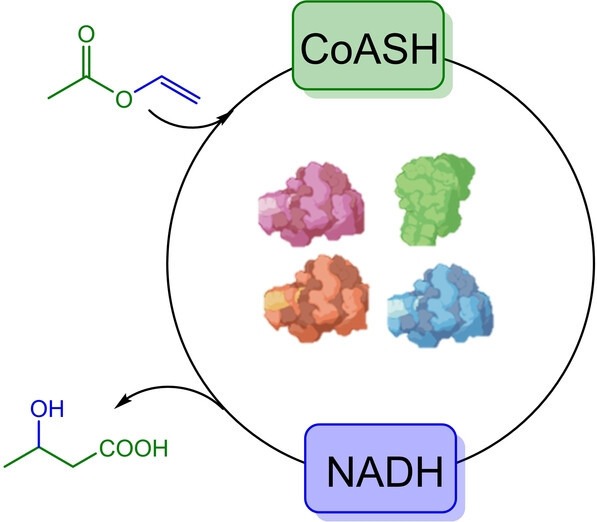
A 4-enzyme cell-free system transforms vinyl esters into β-hydroxy acids in the absence of ATP and ancillary electron donors through concurrent abiotic thiolysis, non-decarboxylating Claisen condensation, ketone reduction and hydrolysis steps. The same substrate provides the energy to activate the acyl group and the redox power to reduce the condensed ketone.
Thermoelectrics | Hot Paper
Dynamic Lone Pair Expression as Chemical Bonding Origin of Giant Phonon Anharmonicity in Thermoelectric InTe
- First Published: 25 January 2023
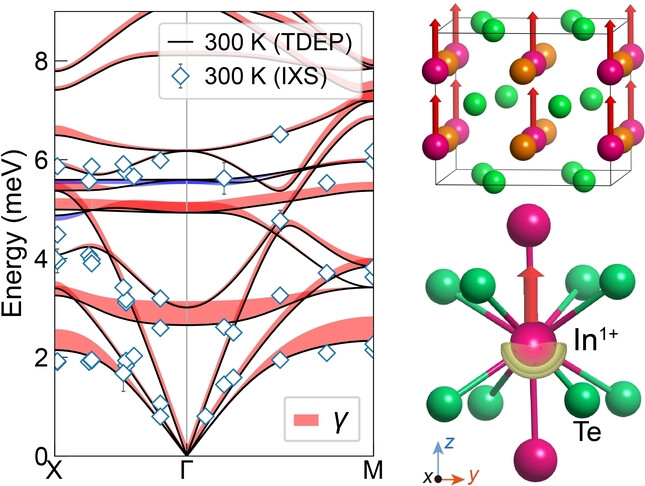
For thermoelectric InTe, we reveal dynamic lone-pair expression as the chemical-bonding origin of giant phonon anharmonicity and intrinsically ultralow lattice thermal conductivity. Our study provides a first detailed microscopic picture connecting dynamical chemical bonding with giant phonon anharmonicity and ultralow thermal conductivity.
Single-Atom Catalysis | Hot Paper
Engineering a Copper Single-Atom Electron Bridge to Achieve Efficient Photocatalytic CO2 Conversion
- First Published: 07 February 2023
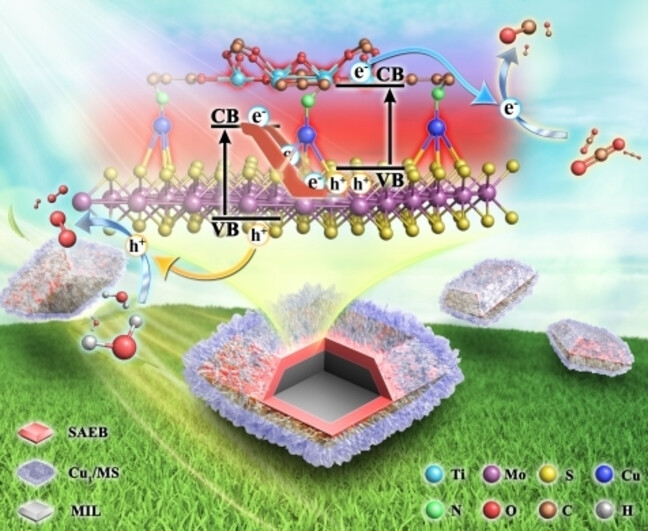
Copper single-atom electron bridges (SAEB) were constructed at the contact interface between Cu1/MoS2 and MIL-125-NH2 to achieve a highly active and stable catalyst for CO2 photoreduction. Empowered by the N−Cu1−S SAEB species, the Z-Scheme charge-transfer process was significantly promoted, leading to enhancement of the photocatalytic CO2RR.
Asymmetric Catalysis
Copper-Catalyzed Chemo- and Enantioselective Radical 1,2-Carbophosphonylation of Styrenes
- First Published: 01 February 2023

Copper-catalyzed chemo- and enantioselective radical 1,2-carbophosphonylation of styrenes from readily available alkyl halides and dialkyl phosphites is developed. The key to the success of the strategy lies in not only the proper choice of phosphorus reagents to suppress the reverse chemoselectivity but also the utilization of a chiral N,N,N-ligand to forge chiral C(sp3)−P bond.
Natural Products | Hot Paper
Structural Determination and Chemical Synthesis of the N-Glycan from the Hyperthermophilic Archaeon Thermococcus kodakarensis
- First Published: 31 January 2023
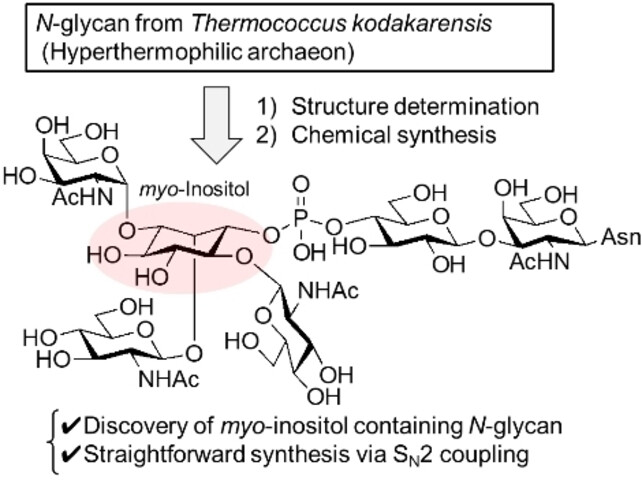
The isolation, structural determination, and chemical synthesis of an N-glycan from the hyper-thermophilic archaeon Thermococcus kodakarensis are reported. The identified N-glycan possesses a highly glycosylated myo-inositol moiety, which is linked to a disaccharide unit through a phosphodiester. Although myo-inositol is ubiquitous in archaea and eukaryotes, inositol-containing N-glycans were unknown until now.
Enzyme Catalysis | Very Important Paper
Total Biosynthesis of Mutaxanthene Unveils a Flavoprotein Monooxygenase Catalyzing Xanthene Ring Formation
- First Published: 02 February 2023
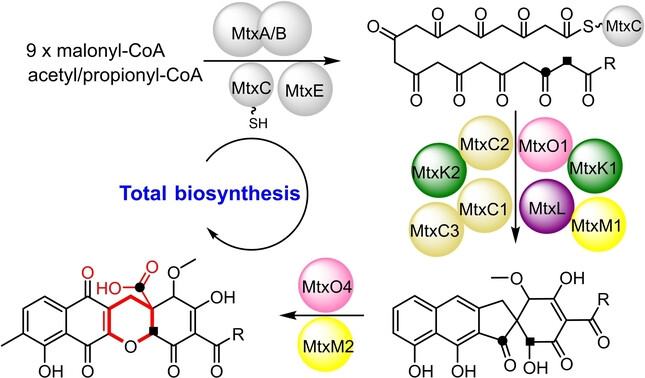
A novel aromatic polyketide containing a xanthene framework and belonging to the mutaxanthene family was discovered through genome mining. The total biosynthesis of this natural product was successfully accomplished using 14 reconstituted enzymes, revealing that a flavoprotein monooxygenase catalyzes a key ring rearrangement and generates the required xanthene ring through a multistep transformation.
Hydrogen-Bonded Organic Frameworks | Very Important Paper
Pore-Environment-Dependent Photoresponsive Oxidase-Like Activity in Hydrogen-Bonded Organic Frameworks
- First Published: 31 January 2023
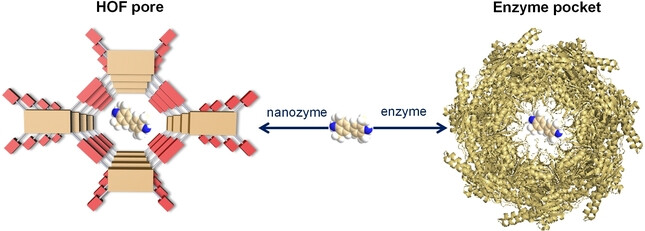
Structurally explicit hydrogen-bonded organic frameworks (HOFs) were used to mimic photo-responsive oxidase. It is shown by constructing isostructural HOFs that the pore environments play an important role in mediating the oxidase-like activity. The enzyme-like activity of the HOFs is associated with the substrate-pore interaction, reminiscent of the binding effect of the native enzyme pocket.
Glasses
Atomic Structural Origin of Fictive Temperature Revealed by AZnP3O9 (A=K, Rb) Glasses
- First Published: 01 February 2023
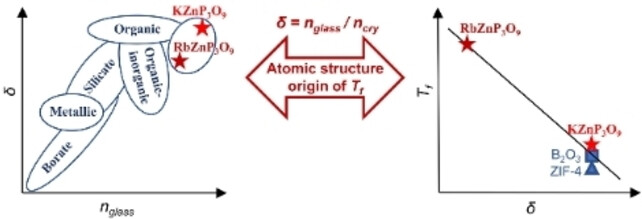
A new evaluation method is provided to judge the glass stability and glass-forming ability. As an example, the reported novel glass KZnP3O9 exhibits the highest δ (δ=1, nglass=8) that quantitatively identifies the short-range order similarity to its crystalline counterpart. The inverse δ-Tf correlation gives the direct evidence for the structural origin of fictive temperature revealing the relaxation thermodynamics.
Photochemical Afterglow
Ultra-long Near-infrared Repeatable Photochemical Afterglow Mediated by Reversible Storage of Singlet Oxygen for Information Encryption
- First Published: 01 February 2023
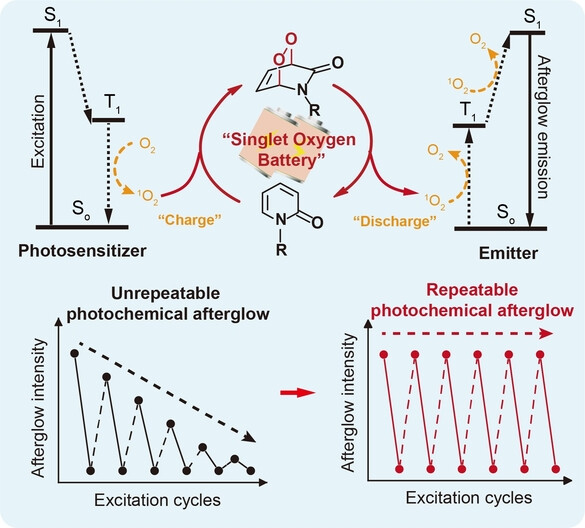
We demonstrated a general strategy to realize repeatable photochemical afterglow (RPA) based on the reversible storage of singlet oxygen. Ultra-long near-infrared afterglow was achieved via the singlet oxygen-sensitized fluorescence approach, and its intensity shows no significant reduction over 50 excitation cycles. The RPA system was further applied for attacker-misleading information encryption, presenting a repeatable read-out.
Photocatalytic CO2 Reduction
Simultaneous co-Photocatalytic CO2 Reduction and Ethanol Oxidation towards Synergistic Acetaldehyde Synthesis
- First Published: 07 February 2023
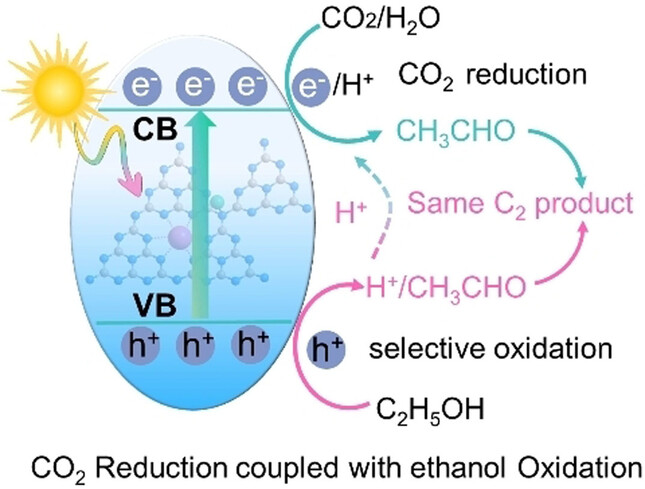
The photoredox system that can simultaneous use photoinduced electrons and holes for solar-driven CO2 reduction coupled with selective ethanol oxidation to one identical value-added CH3CHO product is realized on Rb and K co-modified carbon nitride catalyst, with a benchmark C2 product yield and near-ideal atomic economy.
Transition-Metal Catalysis | Hot Paper
Iridium-Catalyzed Chemo-, Diastereo-, and Enantioselective Allyl-Allyl Coupling: Accessing All Four Stereoisomers of (E)-1-Boryl-Substituted 1,5-Dienes by Chirality Pairing
- First Published: 30 January 2023

We report an iridium-catalyzed highly chemo-, diastereo-, and enantioselective allyl-allyl coupling between branched allyl alcohols and α-silyl-substituted allylboronate esters resulting in enantioenriched (E)-1-boryl-substituted 1,5-dienes. All four stereoisomers with two adjacent chiral centers were obtained by chirality pairing. Mechanistic studies were conducted to understand the high levels of selectivity.
Raman Spectroscopy | Hot Paper
Chemical Enhancement and Quenching in Single-Molecule Tip-Enhanced Raman Spectroscopy
- First Published: 31 January 2023
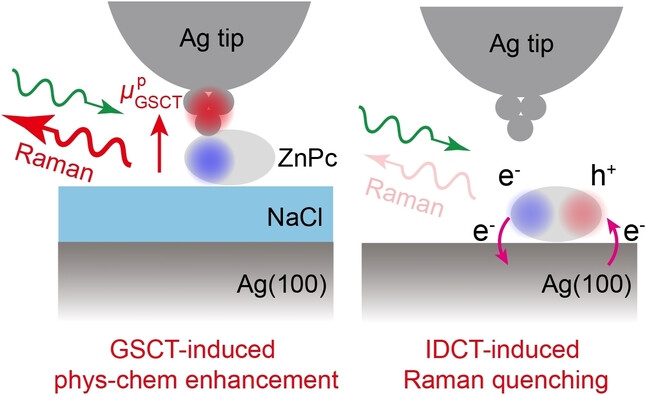
We find that the tip-molecule point contact can dramatically increase the molecular tip-enhanced Raman spectroscopy (TERS) signal via a combined physico-chemical mechanism induced by the ground-state charge transfer (GSCT). In contrast, the TERS signal from a planar molecule chemisorbed flatly on the silver substrate is significantly quenched, mainly due to the polarizability screening induced by the interfacial dynamic charge transfer (IDCT).
Fluorescent Probes | Very Important Paper
Fluorescent Probes Based on AIEgen-Mediated Polyelectrolyte Assemblies for Manipulating Intramolecular Motion and Magnetic Relaxivity
- First Published: 26 January 2023
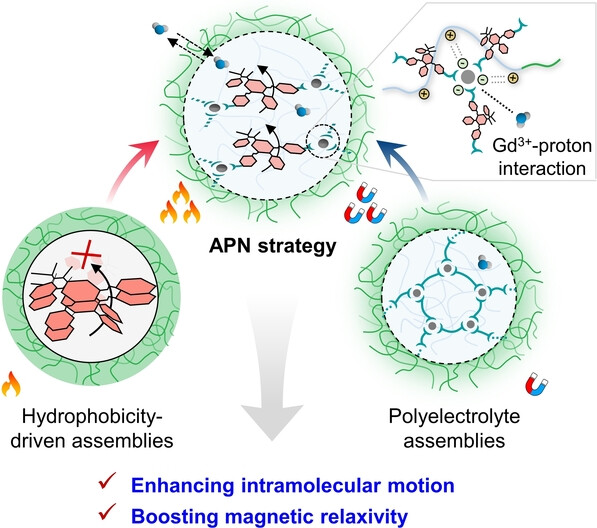
Here we break the bottleneck of uncontrollable inner microenvironment from the hydrophobicity-driven assembling strategy, and present a fluorescent probe based AIEgen-mediated polyelectrolyte nanoassemblies (APN) strategy. By modulating a “soft” and water-rich inner microenvironment in nanotheranostics, APN strategy has for the first time synergistically manipulated both intramolecular motion and magnetic relaxivity.
Membranes | Very Important Paper
Electrochemical Interfacial Polymerization toward Ultrathin COF Membranes for Brine Desalination
- First Published: 04 February 2023
Organic Zn-ion Batteries
Proton-Conductive Supramolecular Hydrogen-Bonded Organic Superstructures for High-Performance Zinc-Organic Batteries
- First Published: 25 January 2023
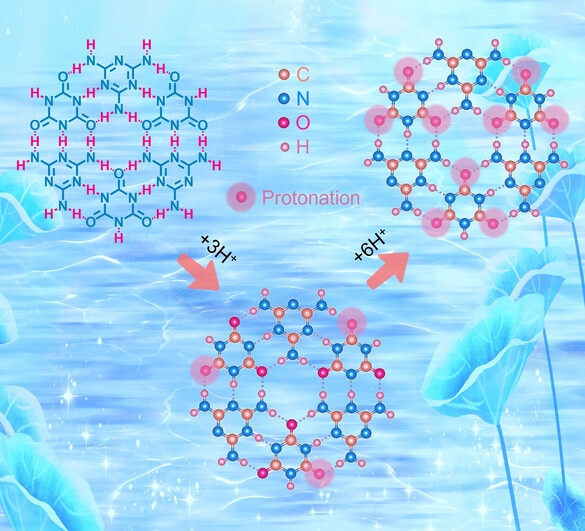
Supramolecular hydrogen-bonded organic superstructures are designed, which empower high-kinetics Grotthuss proton conduction to deeply access built-in protophilic oxygen motifs via a two-step nine-electron (de)coordination reaction, endowing the assembled Zn-organic battery ultrahigh energy density, superior rate capacity and ultra-stable cyclability.
Sustainable Polymers | Very Important Paper
Chemically Recyclable Polyethylene-like Sulfur-Containing Plastics from Sustainable Feedstocks
- First Published: 03 February 2023
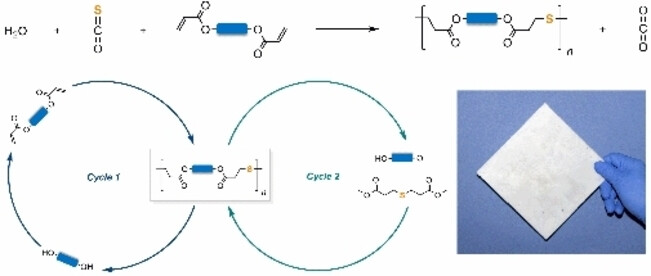
We synthesized a new family of chemically recyclable polymers in a large scale from the sustainable monomers H2O, COS, and diacrylates. Such resultant polymers manifest impressive toughness and ductility comparable to commodity polyethylene. The chemical recycling of these polymers can be readily achieved through two closed loops.
Photocatalysis
Plasmonic Cu Nanoparticles for the Low-temperature Photo-driven Water-gas Shift Reaction
- First Published: 03 February 2023
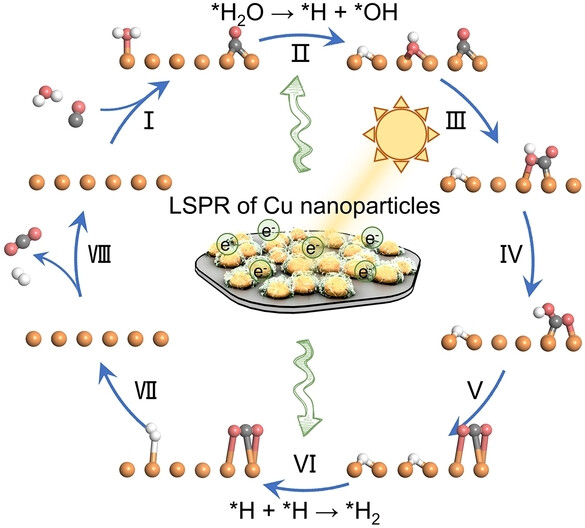
A layered double hydroxide-derived plasmonic Cu catalyst was synthesized for the photo-driven water-gas shift reaction (WGSR). Light-induced hot electrons led to efficient *H2O activation and *H combination via a carboxyl pathway. High hydrogen production rate (114.35 μmol gcat−1 s−1) was realized at 200 °C through the plasmonic Cu-mediated strategy, representing state-of-the-art performance for (photo-)thermal WGSR catalyst at low temperatures.
Biomass
Synthesis of Cyclopentadiene and Methylcyclopentadiene with Xylose or Extracted Hemicellulose
- First Published: 03 February 2023

A highly integrated two-step strategy was developed for the selective synthesis of renewable cyclopentadiene (CPD) and methylcyclopentadiene (MCPD) with xylose or the hemicelluloses extracted from real biomass. Compared with the conventional fossil route, the new synthetic strategy has evident advantages in the renewability and higher availability of feedstock.
Covalent Organic Frameworks
Record Ultralarge-Pores, Low Density Three-Dimensional Covalent Organic Framework for Controlled Drug Delivery
- First Published: 23 January 2023
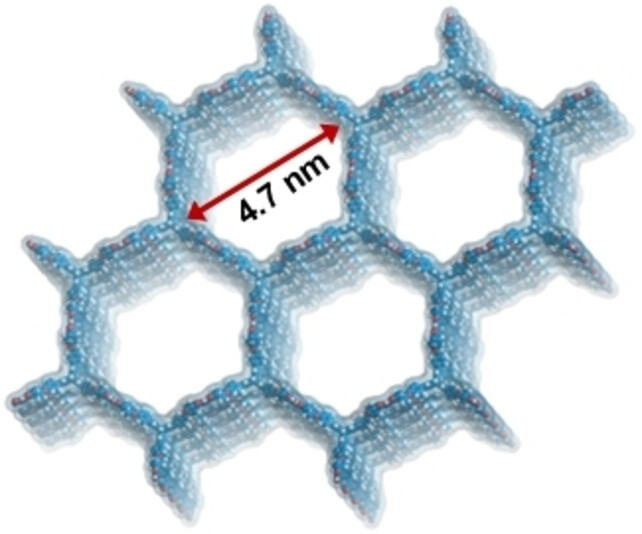
Record ultralarge-pores (47 Å), low density (0.106 g cm−3) three-dimensional non-interpenetrated stp net COF, TUS-64, was obtained by reticulating a 6-connected triptycene-based linker with a 4-connected porphyrin-based linker. TUS-64 displayed the significant qualities of a drug delivery vehicle: controlled release kinetics, sustained delivery, and site-specific targeting.
Hydrogels
Bending Actuation of Hydrogels through Rotation of Light-Driven Molecular Motors
- First Published: 30 January 2023
Polyaromatics
Tetrazo[1,2-b]indazoles: Straightforward Access to Nitrogen-Rich Polyaromatics from s-Tetrazines
- First Published: 29 January 2023
![Tetrazo[1,2-b]indazoles: Straightforward Access to Nitrogen-Rich Polyaromatics from s-Tetrazines](/cms/asset/f807e705-7ba7-4554-81e6-bf4687c66217/ange202300571-toc-0001-m.jpg)
The straightforward access to a new class of aza-polyaromatics is reported starting from fluorinated s-tetrazine. The tetrazo[1,2-b]indazoles display solid-state π-stacking, low reduction potential, absorption in the visible range up to the near-infrared and intense fluorescence, depending on the molecular structure.
Water Splitting
Alloying-Triggered Phase Engineering of NiFe System via Laser-Assisted Al Incorporation for Full Water Splitting
- First Published: 31 January 2023
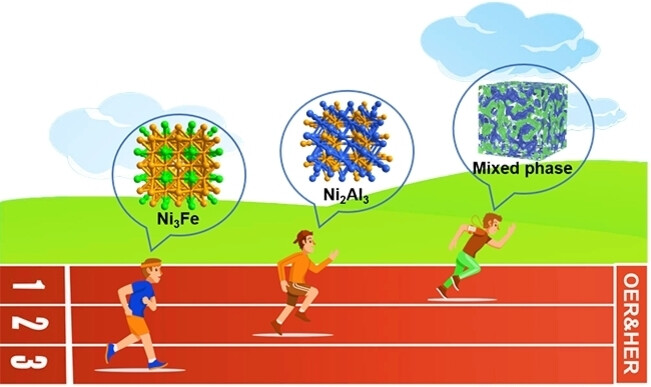
A self-standing hybrid system consisting of Ni2Al3 and Ni3Fe phases was constructed by laser-assisted aluminum incorporation on nickel foam (NF) for full water splitting. Ni18Fe12Al70 (Ni2Al3 and Ni3Fe) delivers an extremely low overpotential to trigger HER and OER processes with better performance than individual Ni60Fe40 (Ni3Fe phase) and individual Ni30Al70 (Ni2Al3 phase), allowing a design strategy of efficient bifunctional electrocatalysts.




